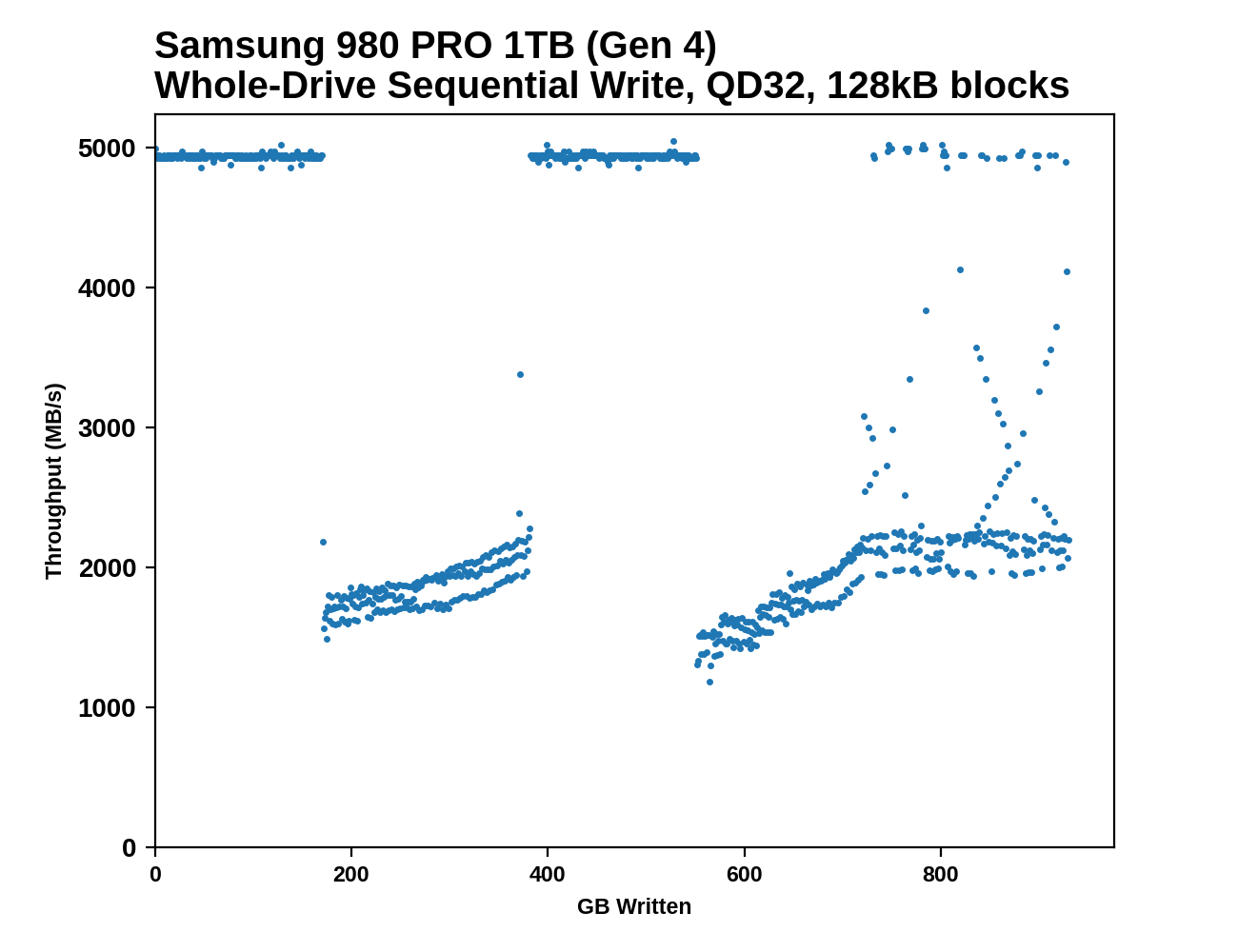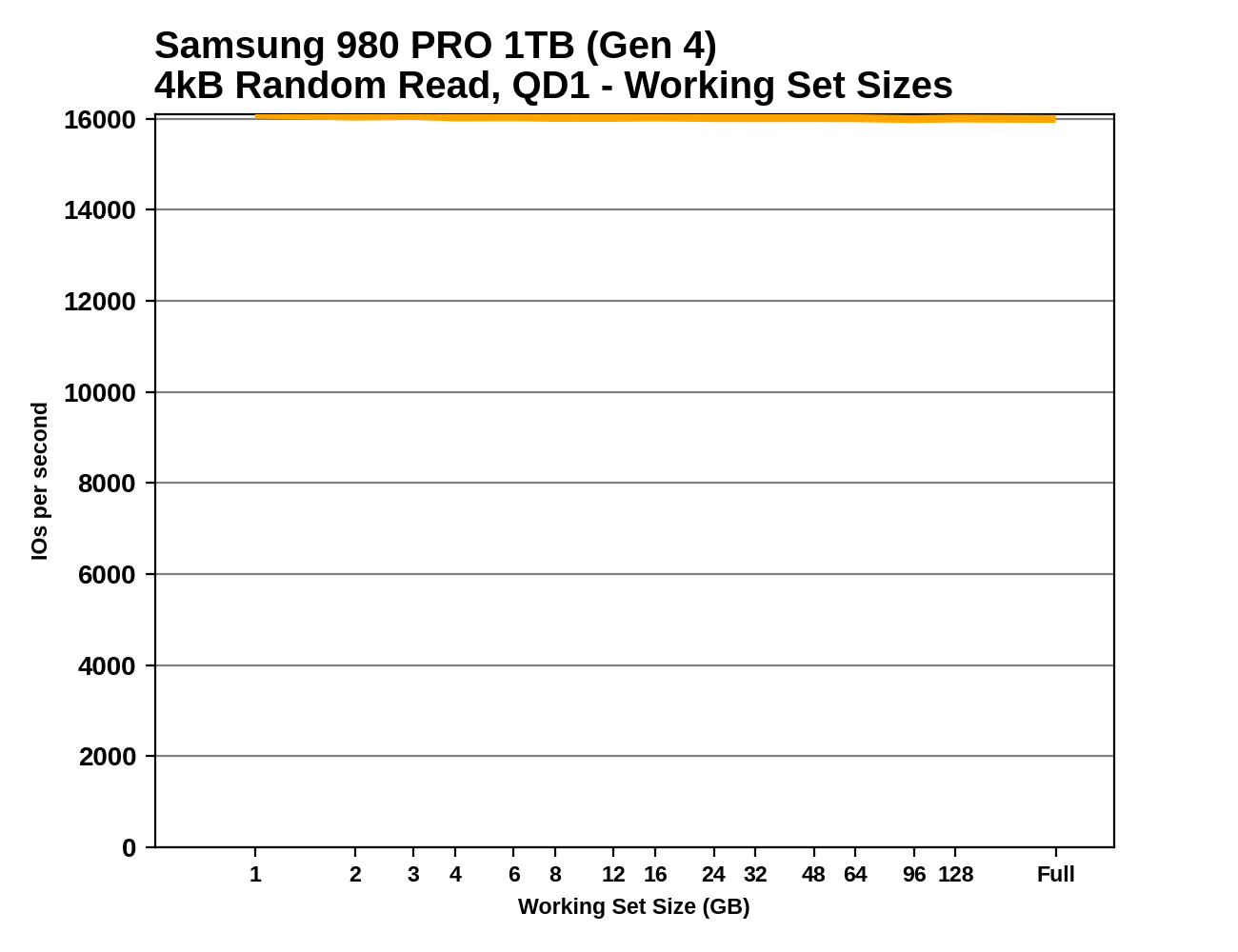The Samsung 980 PRO PCIe 4.0 SSD Review: A Spirit of Hope
by Billy Tallis on September 22, 2020 11:20 AM ESTWhole-Drive Fill
This test starts with a freshly-erased drive and fills it with 128kB sequential writes at queue depth 32, recording the write speed for each 1GB segment. This test is not representative of any ordinary client/consumer usage pattern, but it does allow us to observe transitions in the drive's behavior as it fills up. This can allow us to estimate the size of any SLC write cache, and get a sense for how much performance remains on the rare occasions where real-world usage keeps writing data after filling the cache.
 |
|||||||||
Both tested capacities of the 980 PRO perform more or less as advertised at the start of the test: 5GB/s writing to the SLC cache on the 1TB model and 2.6GB/s writing to the cache on the 250GB model - the 1 TB model only hits 3.3 GB/s when in PCIe 3.0 mode. Surprisingly, the apparent size of the SLC caches is larger than advertised, and larger when testing on PCIe 4 than on PCIe 3: the 1TB model's cache (rated for 114GB) lasts about 170GB @ Gen4 speeeds and about 128GB @ Gen3 speeds, and the 250GB model's cache (rated for 49GB) lasts for about 60GB on Gen4 and about 49GB on Gen3. If anything it seems that these SLC cache areas are quoted more for PCIe 3.0 than PCIe 4.0 - under PCIe 4.0 however, there might be a chance to free up some of the SLC as the drive writes to other SLC, hence the increase.
An extra twist for the 1TB model is that partway through the drive fill process, performance returns to SLC speeds and stays there just as long as it did initially: another 170GB written at 5GB/s (124GB written at 3.3GB/s on Gen3). Looking back at the 970 EVO Plus and 970 EVO we can see similar behavior, but it's impressive Samsung was able to continue this with the 980 PRO while providing much larger SLC caches—in total, over a third of the drive fill process ran at the 5GB/s SLC speed, and performance in the TLC writing phases was still good in spite of the background work to flush the SLC cache.
 |
|||||||||
| Average Throughput for last 16 GB | Overall Average Throughput | ||||||||
On the Gen4 testbed, the overall average throughput of filling the 1TB 980 PRO is only slightly slower than filling the MLC-based 970 PRO, and far faster than the other 1TB TLC drives. Even when limited by PCIe Gen3, the 980 Pro's throughput remains in the lead. The smaller 250GB model doesn't make good use of PCIe Gen4 bandwidth during this sequential write test, but it is a clear improvement over the same capacity of the 970 EVO Plus.
Working Set Size
Most mainstream SSDs have enough DRAM to store the entire mapping table that translates logical block addresses into physical flash memory addresses. DRAMless drives only have small buffers to cache a portion of this mapping information. Some NVMe SSDs support the Host Memory Buffer feature and can borrow a piece of the host system's DRAM for this cache rather needing lots of on-controller memory.
When accessing a logical block whose mapping is not cached, the drive needs to read the mapping from the full table stored on the flash memory before it can read the user data stored at that logical block. This adds extra latency to read operations and in the worst case may double random read latency.
We can see the effects of the size of any mapping buffer by performing random reads from different sized portions of the drive. When performing random reads from a small slice of the drive, we expect the mappings to all fit in the cache, and when performing random reads from the entire drive, we expect mostly cache misses.
When performing this test on mainstream drives with a full-sized DRAM cache, we expect performance to be generally constant regardless of the working set size, or for performance to drop only slightly as the working set size increases.
 |
|||||||||
Since these are all high-end drives, we don't see any of the read performance drop-off we expect from SSDs with limited or no DRAM buffers. The two drives using Silicon Motion controllers show a little bit of variation depending on the working set size, but ultimately are just as fast when performing random reads across the whole drive as they are reading from a narrow range. The read latency measured here for the 980 PRO is an improvement of about 15% over the 970 EVO Plus, but is not as fast as the MLC-based 970 PRO.










137 Comments
View All Comments
5j3rul3 - Wednesday, September 23, 2020 - link
980 Pro (X)980 EVO (O)
DarkMatter69 - Wednesday, September 23, 2020 - link
Could the comparison include some of the fastest M.2 SSDs already in market, e.g. Sabrent Rocket 4, Corsair MP600, Aorus NVM, etc.? the comparison drives used in this article are not the fastest ones, so it is difficult to understand how good is this M.2 drive vs all the other top ones in the market already. Thank you!Slash3 - Wednesday, September 23, 2020 - link
I'd also like to see a few more models make their way through the Anandtech tests, but the Seagate Firecuda 520 in this review is essentially representative of the models you listed. They're all based on what are effectively reference Phison E16 designs and can even be cross-flashed with the same firmware. Upcoming Phison E18 based drives should shake things up a little bit more and will be the true point of comparison for the 980 Pro.Koenig168 - Wednesday, September 23, 2020 - link
980 Evo masquerading as 980 Pro.yetanotherhuman - Wednesday, September 23, 2020 - link
TLC != Pro. Forget it. 2-bit or bust.twtech - Wednesday, September 23, 2020 - link
The write endurance on this drive is identical to the 970 EVO. Yeah, it may be a bit faster - especially being PCIE 4.0 - but it's not like you can use it in ways that you can't use the (much cheaper) non-Pro drives now.Whiteknight2020 - Wednesday, September 23, 2020 - link
And you are entirely missing the point. "Pro" is a generic, meaningless, marketing term. Just look on Amazon for "pro" branded items, ranging from cheap tat to quality (for specific use cases) items. You are choosing to interpret the way a marketing/branding term has previously been applied to product by a manufacturer as having a fixed value and meaning which it does not, it is merely branding and ascribes no specific technical, functional or physical properties to the product. That you are entitled to be aggrieved at the way the branding is used is not in question, what is is your giving the branding a meaning which it does not have.XabanakFanatik - Wednesday, September 23, 2020 - link
Pro is not a generic, meaningless marketing term. Pro is a branding on Samsung SSD's that Samsung has been cultivating for a decade, which has a very well-defined meaning. Samsung Pro SSD's are 2-bit MLC with sustained write performance and high endurance.This drive has none of the three things that has defined a Samsung Pro SSD for a decade.
They just threw a decade of brand building away with one product.
edzieba - Wednesday, September 23, 2020 - link
The near-zero change in random performance at QD1 for PCIe 3 vs. 4 was expected, but the very lot bump in high-QD sequential transfers was not. It's abundantly clear that PCIe 4 bandwidth, at least for desktop use, has no practical applications as of yet.lightningz71 - Wednesday, September 23, 2020 - link
I wonder how the lower end NVME drives will fare when they move to PCIe 4.0? One of the hangups of using host drive map caching was the slower data path between the drive controller and the host memory that was imposed by having to cross the PCIe 3.0 lanes to get to the host memory. Eventually, cacheless controllers will move to PCIe 4.0. Will it be cheaper to make a cacheless PCIe 4.0 controller that actually uses all 4 lanes (some of the cheapest PCIe 3.0 cacheless controllers only used 2 lanes) than to stay with a more mature PCIe 3.0 controller that has a modest amount of cache with it? Will the performance be close enough to make that decision moot?